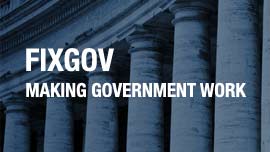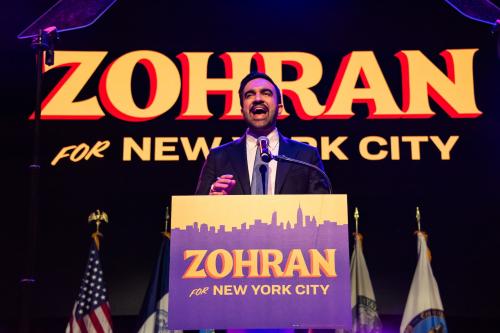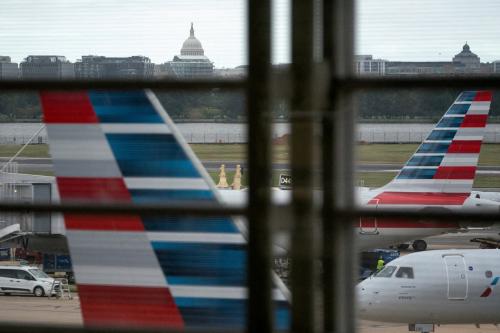President Trump entered office, immediately showing a willingness to use every tool of the administrative presidency at his disposal. In the early days of his administration, he made a record number of nominations, issued a record number of executive orders, and quickly took actions to alter agency payments and personnel.
While Trump has maintained a breakneck speed in some areas of his administration, his momentum on filling agency leadership positions has dissipated over the course of his first 300 days in office. Under more intense scrutiny from the Senate and press, Trump has withdrawn many nominees from Senate consideration, and others have stalled in a gridlocked Senate confirmation process.
With the first year of the Trump administration almost complete, Trump’s approach to personnel and the state of the confirmation process is much clearer. Three key trends stand out:
- Trump’s record-setting pace in making nominations in the first 100 days has all but come to a halt. Trump’s number of nominations (43) in days 201 to 300 is roughly a third of the historical average number of nominations between Reagan and Biden.
- Trump has shown a greater emphasis on Cabinet department nominations than any modern president and much less focus on judicial nominations than in his first term.
- Despite continuous pressure on Senate Republicans, Trump’s nominees have faced significant confirmation delays. Just since his first term, the average confirmation delay (145 days) has more than doubled.
Pace of nominations
President Trump sent 450 nominations to the Senate in the first 300 days of his second administration, just one more than the average of his predecessors since Reagan. While Trump made over 20% more nominations than he did at the same point in his first term, he has fallen behind presidents Reagan, W. Bush, Obama, and Biden.
Trump’s track record at the 300-day mark is such a stark decline from the beginning of his administration that it might surprise observers. In the first 100 days, the number of nominations far exceeded his predecessors. This early speed suggested that he had learned a lesson from the first administration, understanding the importance of transition planning and its associated benefit of staffing the executive branch. However, by day 300, it has become clear that the pace of nominations has dropped off considerably. Trump’s 43 nominations in days 201 to 300 are roughly a third of the historical average number of nominations (123) in the same period for the previous seven administrations.
A closer examination of nominations helps clarify the story. Historically, there is a standard rhythm to nominations. Presidents traditionally make a large batch of nominations on Inauguration Day, followed by spikes in nominations in April prior to the 100-day mark and a steady stream of nominations between June and October (setting aside August for the recess in the Senate). Trump broke the historical rhythm. He entered office making nearly three times the number of nominations (66) on Inauguration Day as the average (24) between Reagan and Biden. Unlike his predecessors, he did not lose speed in February and March. Instead, he increased the pace, making more nominations in each subsequent month. However, Trump’s personnel team seems to have run out of steam after March. Since April, Trump has made the fewest number of nominations of any president since Reagan in all but two months, where he made the second fewest in May and June.
Trump’s personnel priorities
Presidential appointments are critical to any president’s ability to steer agency budgets, program administration, and policymaking, shape the federal judiciary, and influence federal prosecutions. By examining Trump’s patterns in nominations, we can gain a sense of where the administration placed the greatest focus in the first 300 days.
Trump placed greater emphasis on Cabinet department nominations than any president since Reagan
President Trump prioritized making nominations to Cabinet departments more than any modern president since Reagan. Out of all of his nominations, 64% have been to the 15 Cabinet departments (in the line of presidential succession). This is 7 percentage points more than the average between Reagan and Biden, representing almost 39 more nominations to Cabinet departments for an average administration. The contrast is even starker compared with Trump’s first term. Trump has made 83 more nominations to Cabinet departments this administration than in his first.
The largest uptick occurred at the Department of Veterans Affairs, an increase of 67% compared to the baseline set under the Clinton-Biden administrations. President Trump has made 14 nominations to the department, twice as many as President Biden in the same period of time. The prioritization of the VA is also apparent in President Trump’s FY 2026 budget proposal, in which he sought a 10% increase in the department’s budget. Interestingly, however, almost half of these nominations have been withdrawn. There were a variety of reasons for the withdrawals. Two nominees were withdrawn so that they could be nominated for other positions within the department; one withdrew for personal reasons, and another was withdrawn after it was revealed they had donated to Mitch McConnell’s previous reelection campaign.
The Department of Defense (DOD) is the second area of focus for President Trump. He has made 56 nominations, a total that is nearly 50% greater than the average number of nominations for the Clinton-Biden administrations. The DOD has received increased attention as President Trump and Secretary of Defense Hegseth seek to transform the department, from requesting a 13% budget increase to substantial changes in its internal processes and standards.
Despite the central role of the Department of Homeland Security (DHS) in the president’s immigration agenda, DHS has seen the largest relative decrease in nominations from Trump (-32%). Trump’s 10 nominations to the agency at the 300-day mark are three fewer than he made in his first term and half the number of nominations made by President Obama. To date, the White House has not sent nominations for critical positions like the director of Immigration and Customs Enforcement, the administrator of the Federal Emergency Management Agency, and the administrator of the Transportation Security Agency. Trump has shown a preference for using interim acting officials in some positions, like the director of Immigration and Customs Enforcement, and has called for the “phasing out” of other agencies like the Federal Emergency Management Agency.
Perhaps more predictably, President Trump has made substantially fewer nominations (-20%) to the Department of Education. In March, the president signed an executive order demanding the dismantling of the department. To date, the Department’s deputy secretary, general counsel, and chief financial officer positions are all vacant with no pending nominees.
Trump’s overall Cabinet nomination strategy shows a mismatch between priorities and action. Although the Departments of Homeland Security and Justice are central to his agenda, both have experienced some of the largest relative declines in nominations. Meanwhile, the Departments of Energy and Transportation received more attention from Trump than is typical for presidents since Clinton, even though they are not among his top priorities.
Trump is far less focused on judicial nominations than in his first term
Despite his frequent frustration with federal court rulings, President Trump has shown much less interest in judicial nominations. Through the first 300 days, the White House has only made 32 judicial nominations, less than half the number he made in his first term (73).
One reason for Trump’s diminished focus on judicial nominations may be that there were fewer vacancies to fill (he came into office with only 45 judicial vacancies). This is a far cry from 2017, when Trump entered office with 112 judicial vacancies, largely due to a refusal of the Senate Republican majority to confirm many of President Obama’s judicial nominees in 2015-2016. However, a lower number of vacancies has not prevented other presidents from focusing on judicial nominations. Despite entering office with only 49 judicial vacancies, President Biden made 71 judicial nominations in his first 300 days.
Another reason for Trump’s lower number of judicial nominations may be his split with the Federalist Society, the organization largely credited with supporting Trump’s efforts to reshape the federal judiciary and supplying candidates for nominations in his first term. The administration may be more selective in its identification of candidates as it tries to identify ones inclined to be “America First judges.”
Confirmation delay
My colleague Kathryn Dunn Tenpas shows that there have been significantly more Senate confirmations during days 201 to 300 than any president since George W. Bush. This is largely due to the Senate’s use of its new bundling tool to vote on two large packages of nominations much more efficiently.
Despite making gains in the number of confirmations, President Trump’s nominees have experienced the longest average confirmation delay (145 days) of any president since Reagan. The delays are over 5.5 times more than experienced during the Reagan administration (26 days) and more than two times longer than Trump’s nominees faced in his first term (68 days).
This level of delay can lead to negative outcomes on several fronts. First, it creates significant challenges for nominees and their families as they sit in limbo for months waiting for action on their nomination. Second, the delay disincentivizes candidates from wanting to seek a Senate-confirmed role in the first place, limiting the pool of candidates. Finally, it creates a perverse incentive for the president to fill roles via interim appointments, rather than going through the confirmation process. Why wait nearly five months on average to get your nominee in place when you can use a non-Senate-confirmed appointee to fill the role immediately?
Confirmation delays are likely to increase moving into the second year of the administration. On average, delays increase by 64% between the first 300 days and the end of the second year. If the confirmation delay faced by President Trump’s nominees increases by this amount, the average confirmation delay is projected to be 237 days by the two-year mark.
Conclusion
President Trump is at risk of repeating one of the core patterns of his first administration—longstanding, persistent vacancies in critical Senate-confirmed agency leadership positions. The combination of the declining pace of nominations, frequent withdrawals of nominees, and substantial confirmation delay will inevitably result in many critical vacancies.
High profile positions like the deputy secretaries of Education and Treasury, the undersecretary for Food, Nutrition and Consumer Services (responsible for overseeing programs like the Supplemental Nutrition Assistance Program (SNAP) and the Special Supplemental Nutrition Program for Women, Infants, and Children (WIC)), the directors of the Centers for Disease Control, Immigration and Customs Enforcement, and Bureau of Alcohol, Tobacco, Firearms and Explosives, the administrators of the Administration of Children and Families, Federal Emergency Management Agency, and Transportation Security Agency, and the commissioners of the Census Bureau, Internal Revenue Service, and Bureau of Labor Statistics are all vacant without pending nominations. The president and the White House Personnel Office still have critical work to do to recruit, vet, and assist nominees through the confirmation process.
Of course, President Trump may also be perfectly content with vacancies across his administration. He previously stated in his first term that he likes using acting officials and that they provide him flexibility to “make moves.” Trump has shown this in his handling of the director of Immigration and Customs Enforcement position. Rather than naming a nominee for the director during the presidential transition, Trump announced who he would select to serve as the acting official, Caleb Vitello. Within a month, Vitello was reassigned for not being aggressive enough in making arrests and replaced with a more compliant director in Todd Lyons. While the president gains flexibility in being able to place whomever he wants into leadership positions via interim appointments, there are significant losses. Vacancies in agency leadership positions contribute to diminished agency performance. Using acting officials as alternatives to Senate-confirmed nominees also circumvents the Senate’s advice and consent role and may result in less qualified, more controversial officials serving in key leadership positions.
President Trump is nearing the end of his first year back in office with a significant loss of steam. His pace of nominations since April has been historically slow, his nominees have been withdrawn at a rate much higher than his predecessors’, and the Senate is taking considerably longer to confirm his nominees than any modern president. With a high level of turnover in the Presidential Personnel Office, it might be difficult for the administration to gain back momentum. Instead, the president may increase his reliance on acting officials as he moves into his second year, and officials begin to turn over.
The Brookings Institution is committed to quality, independence, and impact.
We are supported by a diverse array of funders. In line with our values and policies, each Brookings publication represents the sole views of its author(s).








Commentary
Momentum lost: Taking stock of Trump’s nominations at the 300-day mark
November 24, 2025